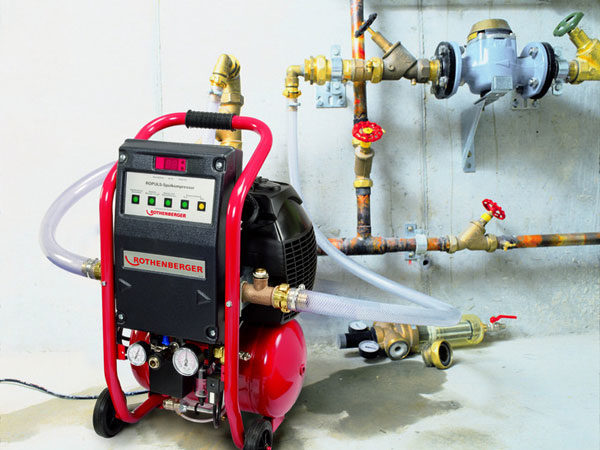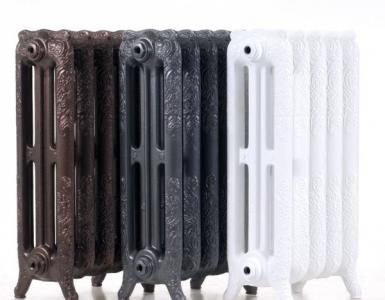Flushing the heating battery without removing it. This method is effective if. Recipes of cleaning products from the smart "nuggets"
Whatever pipes and heating batteries are made, they periodically need to be cleaned.
This is due to the quality of the coolant, which leaves behind particles of slurries and debris that tend to settle on the walls of the radiators, gradually narrowing their internal space.
Flushing of aluminum radiators should be carried out every 5 years to extend the life of the structures.
There are a number of signs that indicate that they need to be cleaned:
- With uneven heating, for example, up to half they are hot, and the second part is cold.
- When the radiator needs more time to warm up than before.
- Washing is necessary when the energy costs for its full-fledged work are much more significant.
These are the main symptoms that require flushing an aluminum radiator. In an apartment with a centralized type of heating it is a necessity, whereas in autonomous systems such a problem as pollution is less common. This is due to the fact that in the first the length of the pipes is much longer and the coolant passes through it, collecting all the rubbish along the way, and the second one can pour filtered water, which will completely deprive the battery of pollution.
Most often inside the radiator you can "find":
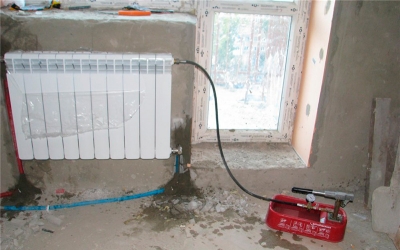
Flushing of radiators should be carried out with a periodicity of 3-5 years with central heating and 5-7 years - with autonomous heating, but pollution prevention is carried out annually.
This is due to the fact that only 1 mm of deposits reduces the efficiency of the design up to 15%, which, in turn, entails an increase in costs during its operation.
To date, there are 3 ways to flush heating systems:
- Chemically.
- Hydraulically.
- Impulsive.
All of them have their advantages and disadvantages, so it is worthwhile to familiarize with each one before choosing how to rinse an aluminum radiator.
Use of chemical agents
Aluminum is an extremely "whimsical" metal. Choosing what and how to rinse aluminum heating batteries, you need to focus exclusively on the means whose composition will affect the deposits, without touching the walls themselves.
Chemical flushing is good because it does not require the dismantling of batteries and it can be carried out even at the height of the heating season.
It is based on 2 stages of work:
- Dissolution of scale.
- Washing and removing them from the system.
The drawbacks of this type of cleaning include increased toxicity of chemical agents. When it is carried out, it is necessary to use protective measures and be very cautious. It also requires attention when diluting the chemical composition, if it is sold as a concentrate. Incorrect proportions can destroy aluminum together with scum.
The most popular is Master Boiler Power concentrate, which is suitable for all types of pipes and radiators. You can also use "folk" remedies, for example, vinegar, whey or caustic soda.
Hydrodynamic flushing
This is one of the most time-consuming methods of cleaning heating system. It is based on a shock jet of water, under the pressure of which the scum exfoliates from the walls of the radiator.
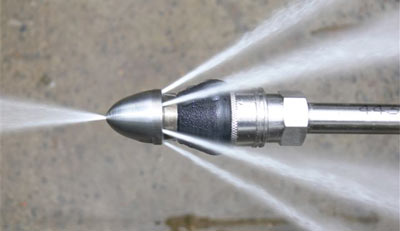 Sequence of works:
Sequence of works:
- The carrier is completely drained from the highway.
- The areas to be washed are determined.
- Part of the pipe is removed, and in its place is connected a hose with a special nozzle, the end of which is introduced into the pipeline.
- Water under the action of the pump under high pressure is fed into the radiator, sweeping away the lime and all debris in its path.
After the cleaning is over, the system should be filled with water and run it several times to remove the scale from the heat sink.
Hydraulic flushing
This work can be carried out in the heating season, as it will only require running water through the system:
- Before starting work, a hose is connected to the drain cock, the second end of which is discharged into the drainage system of the sewage system.
- The tap is opened from the make-up side and a layer of dirt leaves under the flow of incoming water.
- The cleaning can be considered complete after the system has run out pure water.
This method is used for regular washing of batteries. In the event that the system has not been cleaned for a long time and the pollution is strong enough, it will not help.
Pulse flushing
If the question is asked how to clean the aluminum radiator with minimal risk for it, then the answer is unambiguous - by means of impulse flushing.
This is a "young" and progressive method that guarantees safety of aluminum walls of heaters, but special devices are required for its carrying out, therefore, specialists can not be called without calling specialists.
The method is based on a brief impulse effect on water, during which a shock wave is generated, which moves through the system at a pressure of 12 atmospheres. This allows the removal of scales of any thickness without damaging the walls of the radiator, provided that it withstands such a water hammer.
This method is effective if:
- The diameter of the pipes does not exceed 4 inches.
- Even removed at a distance of 60 m from the device that generates impulse action, the radiators are effectively cleaned of scale.
- Impulses do not affect the integrity of the fittings and components of the highway.
Often consumers are wondering how to rinse an aluminum radiator in an apartment with their own hands. It is not difficult to do this, but only after the end of the heating season.
 This is related to the stages of work:
This is related to the stages of work:
- The whole carrier is drained from the heat main.
- Radiators are dismantled.
- If the batteries are very clogged, then they must be disassembled into separate sections, otherwise it is sufficient to rinse them chemical means, filling them with an internal space and holding it inside for an hour.
- Rinse the radiator with running water under pressure to remove scale and residue of chemistry, after which it can be returned to the place.
This procedure requires careful handling of the aluminum radiator, so as not to cause mechanical damage to its external walls, for which the bathroom is covered with a dense rag.
As a rule, aluminum reacts well to the effect of acids and negatively on alkalis, so when asked whether it is possible to rinse the aluminum radiator with citric acid, the answer will be positive. The only thing that should be taken into account is the amount of substance for cleaning efficiency and the time of solution in the system. As a rule, ready-made products are more effective, since they are already diluted to the desired consistency, indicating the duration of the process.
Washing aluminum radiators - this is a prerequisite for the effectiveness and durability of their work. Choosing how to do this, remains for the consumer, but in order not to harm the system, it is better to entrust such delicate work to professionals.
Useful video
In apartments and in private houses, heating systems lose their effectiveness over the years, which leads to a decrease in the quality of housing heating. Among all the most common causes of this phenomenon, experts highlight the problem of radiator contamination. This is a fairly simple explanation: the coolant circulates through the heating circuit and destroys the internal surface of the heating devices.
In addition, the water contains some impurities that are able to settle inside the heat exchangers. Hence, pollution, clogging and, correspondingly, a reduction in the useful volume of radiators, which leads to a decrease in the efficiency of their operation. And the only correct version of the solution (with the exception of replacing the heat exchangers with new ones) is flushing the heating batteries.
Causes of Pollution of Heating Devices
There are several reasons that are caused by the need to clean the radiators:
- uneven heating of the heat exchanger - the lower part is cold, and the upper one - hot or vice versa;
- decrease in the rate of heating of the radiator in comparison with the previous heating seasons;
- the thermal main is hot, while the radiators themselves are cold;
- increase in energy consumption at a constant coolant temperature.
At present, the owners of apartments and houses prefer bimetallic and cast-iron radiators. Bimetal in comparison with other materials is the most inexpensive, but quite effective. Cast iron is more a tribute to traditions, although today radiators are made in different styles, which makes it almost an independent element of the interior.
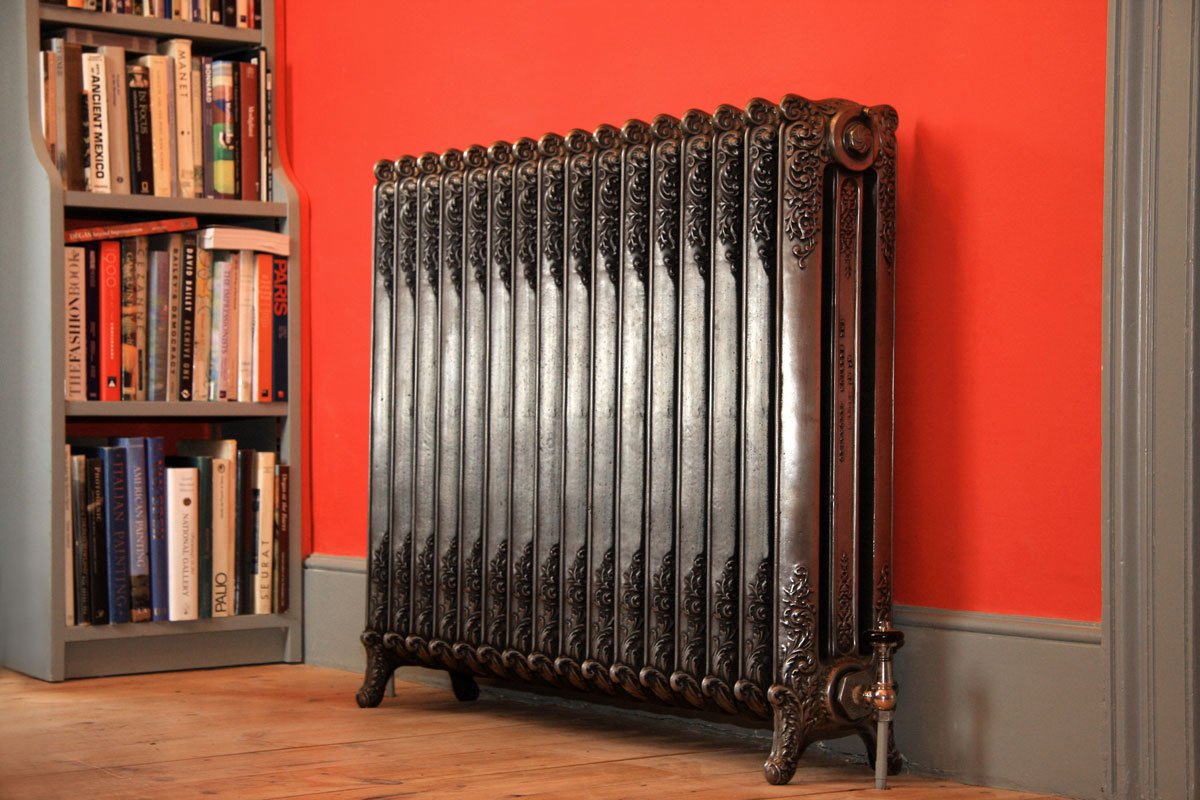
The method of cleaning and how to rinse the batteries is, in fact, not related to the material from which they are made. But at the same time, experts recommend using for washing bimetal batteries at home, compounds based on chemical components.
Comparing the two types of heat exchangers, it is worth noting that bimetallic heating devices have much more advantages than cast iron ones. First, they have higher efficiency and heat transfer, and secondly - they do not have significant roughness, and therefore will not quickly become dirty and clogged. And this, in turn, increases the service life of the heater.
Cleaning radiators in apartments

Purge and rinse the batteries only after the end of the heating season.
Before flushing the battery, it is first necessary to drain all liquid from the heat main. After that it is necessary to dismantle the heaters.
To clean the heat exchanger you need a solution based on acetic acid, caustic alkali and whey. In addition, it does not hurt to buy special chemical compounds. You can also use a chemical product such as "Mole" for cleaning activities. It is more used for cleaning sewage, but these goals also come down.

The procedure for purging and rinsing the radiators of the heating system is usually carried out in the bath. And in order to avoid damage to the enamel surface of the sanitary equipment, it is necessary to put a dense rag on the bottom of the bath. On the drain hole it is better to put a mesh that will avoid getting large particles of dirt into the sewer pipe.
If it is necessary to perform such a procedure as cleaning the cast-iron batteries, it is necessary to remove all the plugs on them. The process of cleaning the heat exchangers is as follows:
- Filling hot water. The first flushing is carried out without the use of any auxiliary cleaners. So, after pouring hot water, shake the heating block well and drain the water together with the particles of the internal plaque. Washing the cast-iron batteries is not easy, because this device has a large mass. And if you clean up these heaters, you should resort to outside help, without which you can hardly perform this task at the proper level.
- The second time we fill not with water, but with a prepared solution. If you use vinegar essence for these purposes, then a 70-percent essence bottle will be needed for one radiator. When using any other purchased chemistry, the amount of solution required for cleaning is regulated by the manufacturer. As a rule, this information is on the packaging container. After the cleaning agent has been filled in the heat exchanger, it is necessary to plug all the openings with stoppers and leave the device to "bake" for at least a couple of hours.
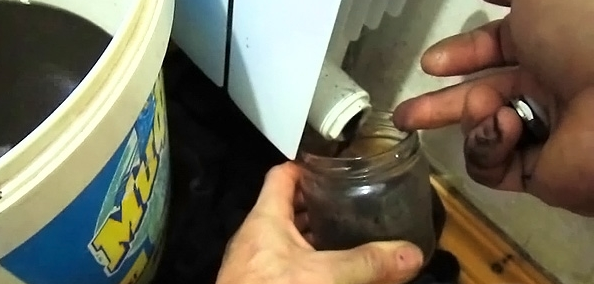
- By the incident of the specified time, the radiator should be shaken well, you can even knock it with a rubber or wooden hammer. This will help to get rid of the scale and rust from the inside of the heater. Then we take into account the caps and pour out the chemical composition.
- Then again you need to fill the water. Rinse the heater until the water leaving it is clean.
If you do not get rid of the remnants of the cleanser completely, then it, in the future, can provoke the destruction of the internal surface of the device, and as a result, they can give a leak.
Cleaning of the heating system in a private house
In suburban buildings, cleaning of heat exchangers is where a big problem, rather than in apartments. This is simply an explanation: as a coolant is used, most often, water is not from a centralized water main, but from wells and reservoirs. This causes the presence in it of large particles of dirt and other formations that contribute to the clogging of the heating system. And, if you do not use the filtered station, then, unfortunately, the radiators will clog up much faster than it happens in the apartments. In the case of living in a private house, the need to wash iron and bimetallic batteries occurs very often.
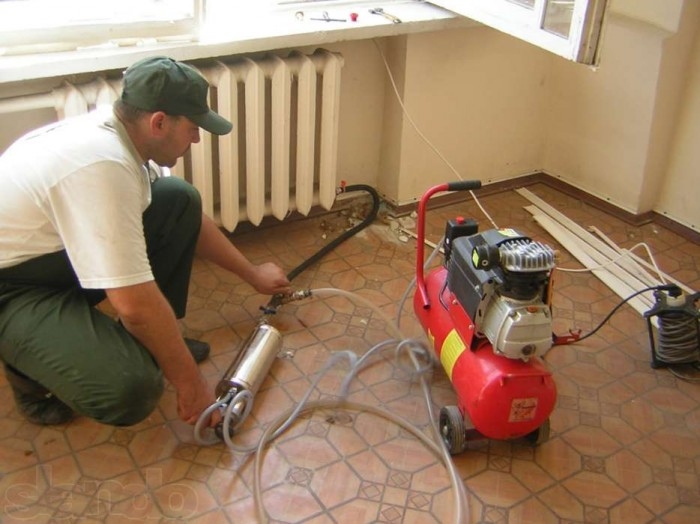
Living in a private house, you need to clean not only the heating appliances, but also the very main, along which the coolant circulates. Otherwise, the garbage in the circuit again gets into the heaters and, as a consequence, washing procedures were a waste of time.
In the case of washing the heaters in a private house does not necessarily wait until the end of the heating season. But, at least, it will be at least inappropriate to carry out similar measures in the winter from the point of view of shutting down the heating system.
VIDEO: Flushing the heating system
Than to wash out pig-iron batteries in a cold season
Yes, all the same special chemicals or folk remedies such as caustic alkali, acetic acid, etc.
There is no need to drain water from the heating boiler. Moreover, in this case it is possible to clean the heating batteries without removing them. The steam line line will completely overlap for the time when the heating blocks are cleaned. After all the necessary valves are closed, and the purging of the heaters is completed, you can proceed to the purification process. For this, it is necessary to run water through the heating circuit.

It is served until the time when clean water begins to flow out of the pipeline without obvious signs of debris in them. Thanks to such measures, it is possible to clean out not only the heat exchangers from pollution, but also the entire highway as a whole.
VIDEO: How to clean the radiator yourself
Washing of boilers and heating systems of private houses.
It is much easier and cheaper to rinse the heating system in advance, than to look for a large sum for repairs or a complete replacement. In addition to the cost of new pipes and a boiler, you will have to pay for the restoration of the interior, which will inevitably be ruined during the installation work.
The company "RosTeploEnergy" offers professional washing services for heating batteries. We work at any time convenient for the client and accept applications from both individuals and legal entities. Customers are given a guarantee for the work done, as well as incentive discounts and bonuses.
In practice, it has been established that for 15 years of operation without washing, clogging of heating batteries with dirt and rust is observed at 40-50% of their volume. In addition, the inner surface of the heat exchanger is covered with a layer of scale, which reduces the thermal conductivity of the metal 40 times. That is, after 15 years without changing the temperature characteristics of the coolant, the heating system will only operate at 50% of its original capacity.
Ways of washing the heating batteries
All this can be avoided by conducting an annual cleaning of the heating system. When preventing heating batteries, the following washing technologies are used:
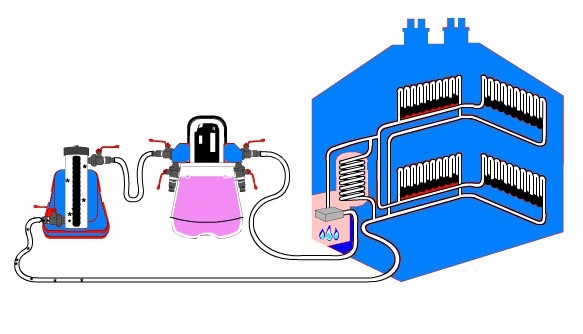
- Chemical. This method of cleaning consists in etching the scale layer from the internal surface of the heat exchanger by means of special reagents. To remove the formed deposits apply solutions of organic or mineral acids, as well as alkalis and complexones.
- Hydropneumatic. This washing technology consists in the simultaneous supply of a jet of water and air under pressure to the heating battery. Boiling water-air mixture tears the scale, scale and layer of dirt from the internal walls of the heat exchanger. Increase in efficiency is facilitated by the impulse operation of the supply compressor. Thus, mud deposits in the "suspended" state are discharged by the flow of liquid from the radiator.
- Kinetic Impulse Wave (abbreviated as CIV). Washing of heating batteries is done with the help of special equipment that not only delivers water under pressure, but also causes a series of water hammers. The method is especially effective in removing silt and dirt.
- Integrated. This option of washing the heating batteries is the most effective, since it provides for a series of different cleaning options that are carried out in series. For example, the impact of a pulsed wave, chemical reagents and finally clean water.
Need a professional performer to clean the heating batteries? Contact the company "RosTeploEnergy"!
It seems to us that the heating season always comes on time. As for central heating, everything is strictly in accordance with the established deadlines, so prepare for heating season better in advance. In particular, heating systems that run for a long time require periodic cleaning of the radiators. Especially if it's cast-iron radiators, which are now installed in most apartments. And it does not matter in this case, centralized heating or individual heating, because corrosion acts indiscriminately. Today, there are many ways how to rinse the radiator, but you need to sort out a little with the symptoms that show that your system requires washing.
Cleaning radiators
When it is necessary to clean the radiators
The main indicator of comfort level is the temperature in the room. According to the established norms, its minimum indicator for apartments and houses is 18 ° C, but many begin to feel comfortable only when this indicator reaches 21 ° C, and maybe even higher. What to do if the temperature in the apartment is below the established norms, and the representatives of the municipal services say that the heat is supplied by them in full. Most likely, that's the way it is, just in your apartment radiators hammered - a problem that you have to meet quite often. The following factors say that your radiators require flushing:
- when you try the heating pipe, you suddenly find that its temperature is much higher than the temperature of the radiators;
- in one room radiators work with maximum efficiency, and in another they are hardly warm or do not warm at all;
- in the apartment of your neighbors on the riser is warm, and you do not stop complaining about the quality of heating in your apartment;
- the radiator of heating in its upper part is slightly warm, and its bottom is cold;
- the radiator sections are not heated equally.
If at least one of these symptoms is detected, then it is necessary to start "treating" your radiators.
This can be done in many ways, but it is necessary to do this, since it will still have to pay for heating. And for what to pay, you will set yourself a quite logical question. Thus, without delay, the problem must be solved. If you do not already know how to wash the radiator, we recommend to talk to specialists, or carefully read this manual.

Pneumatic impulse cleaning of radiator
What are the ways to clean the radiator
Most of the apartments in the old building are still equipped with cast-iron radiators, which require periodic cleaning and washing. If you use central heating services, then it is advisable to do this together with neighbors. It is somewhat easier for those who live in private houses or apartments equipped with autonomous heating systems. In this case, you do not depend on the whims of the public utilities, and neighbors do not have to beg. Only your desire is enough. What are the ways of washing the radiators of heating:
- Centralized flushing of risers, which is used in conditions apartment buildings. Such measures are very effective, since in this case a progressive hydropneumatic washing technique is used. It consists in the fact that in the riser heating system under high pressure a mixture of compressed air and water is fed. At the same time the mixture is supplied by special compressors with a certain periodicity. As a result of incoming impulses, air bubbles form in the water, which contribute to the detachment of the deposits on the inside of the radiator. This method is very effective, however, certain investments are needed for this.
- Individual cleaning of radiators that can be manufactured different ways. Such cleaning is associated with the complete dismantling of heating appliances, which sometimes causes some difficulties. In addition, it is often a long and painstaking process, but the financial costs are minimal.
Considering the fact that most of the apartments and especially private houses are now equipped with autonomous heating systems, it is worthwhile to stop individual radiator flushing special attention. There are several ways that you can flush the radiators yourself. To a greater extent this applies to cast-iron radiators, however, it is possible in the same way to clean cast-iron ones and even aluminum radiators heating. Consider the most popular method, available to anyone who knows how to hold a gas key.
Basic technology and sequence of washing radiators
If you decide to rinse the radiator yourself, then this will require a simple set of tools necessary for the dismantling and installation of the radiator, rags and cast-iron bath. If you have an acrylic or cast iron bath, but you can do it on the street, you are lucky. In the case of a cast iron bath, everything is done in the following sequence:
- we remove the radiator of heating - unfortunately, this is a forced measure;
- lining the bottom of the bathroom with unnecessary rags to protect the enamel from damage, also for safety, but already the sewage system, install a grid on the drain, which will protect the sewer from getting into it washed solid particles;
- dismantle the mixer by removing the watering can from it, because for this procedure we need a concentrated pressure of water;
- we begin washing the radiator. To achieve a better effect, it must be periodically rotated.
During the flushing of the radiator, it may be necessary to additionally remove the solid particles, which must be pushed specially prepared for this purpose by wire or other improvised means. Thus, it is necessary to wash the radiator until it is completely cleaned. This will tell the clean water, which will flow from them. With regard to washing outdoors, for this you need to stretch the hose with water and do everything in the same sequence. Naturally, after washing the inner surface, it is necessary to clean the radiator from the outside, giving it an aesthetic appearance.
Very good results can be achieved with the use of special devices for rinsing radiators. In this case, no need to dismantle the radiators. However, this method there is a significant drawback - the high cost of equipment, which, considering not frequent work on flushing the radiator, it is inappropriate to buy. Such devices are often used by utilities or construction companies, who often have to deal with this problem.
Flushing radiators with special equipment - video
If it so happens that none of these methods suits you and washing with running water is impossible, you can do it differently. To do this, just fill in the radiator hot water and add a cleaner, it is better to use for this soda ash. After about an hour, tap the radiator with a wooden hammer, drain the water and do this procedure several more times, until it is completely cleaned. Also for this purpose, it is possible to wash the car radiator and milk whey, but such methods are used much less often.
Cast iron radiators, despite the durability and good heat dissipation, require cleaning every 10-15 years of operation. Since during this period clogging and blockage of internal channels occurs, which leads to a deterioration in their heat transfer. Therefore, the question of how to rinse out cast-iron heating batteries at home is quite relevant for people who are used to doing everything themselves.
The pollution of the batteries is mainly due to the appearance of corrosion due to the drainage of water from the heating system during the summer period, as well as the use of a coolant of inadequate quality.
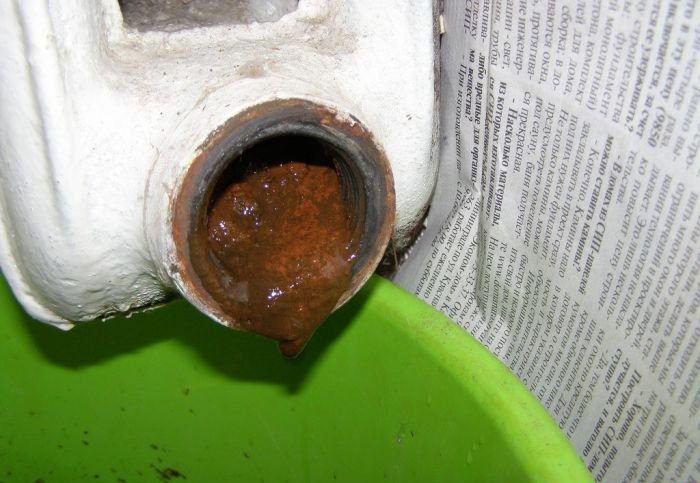
Cleaning of cast-iron batteries at home
If you approach the problem with knowledge of the case, the implementation preventive works on the shoulder to everyone. The main thing is not to flood your apartment, even more importantly - the neighbor's apartment. Naturally, it is best to call a qualified plumber, but if armed with the necessary instructions for dismantling the sections, it will not be difficult to clean the cast-iron radiator. Dismantling and rinsing multisectional radiators entirely alone is problematic, so in this situation an assistant is required.
Important! Before cleaning the cast-iron radiator at home, it is necessary to make sure that the heat supply system in apartment house is disabled, and its operation will not be exactly resumed during cleaning procedures. In a detached house there is no such problem, only it is required to know the weather forecast. In the cold time, work should not be done.
How to rinse the radiators
After dismantling, the cleaning of the heating devices is carried out by flushing all sections of the flow hot water under pressure. In an apartment building, this can be done in a cast-iron bath. For the preservation of the enamel coating, before rinsing out the cast-iron radiators, the bottom of the bath must be covered with a soft cloth.
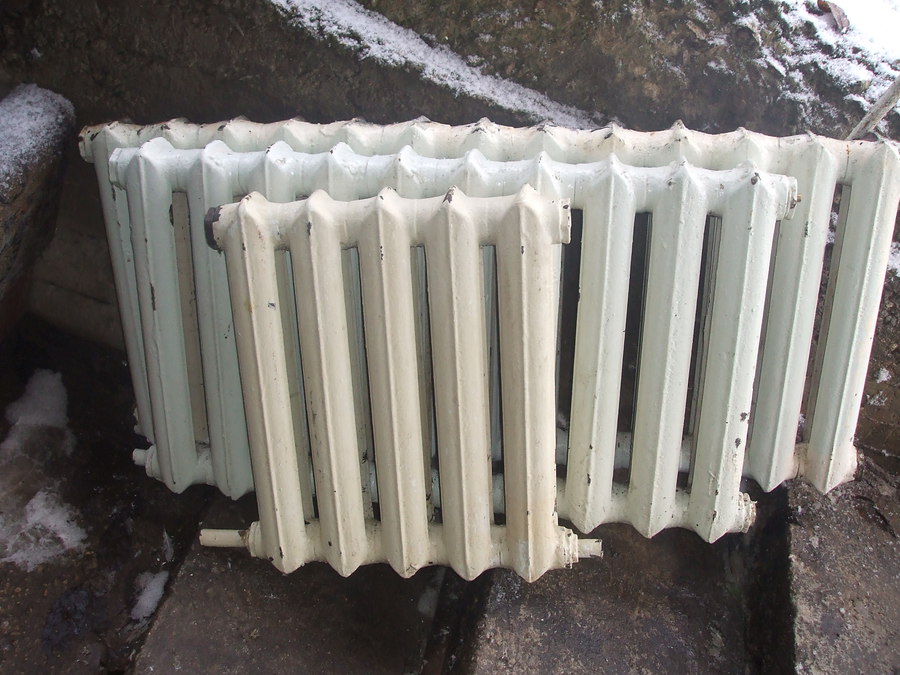
From the instrument, remove all plugs and place them in a vertical position in the bath. To wash the battery, a flexible shower head hose is used. To prevent large contaminants from entering the sewer pipe, the drainage hole of the bath is protected by a special net.
The process of washing the radiator is performed with regular overturns, while water is supplied from a flexible hose under pressure and is sent to all sections. To remove large lumps of contamination, use the appropriate length armature. If the bath is not cast iron, it is better to rinse it on the street.
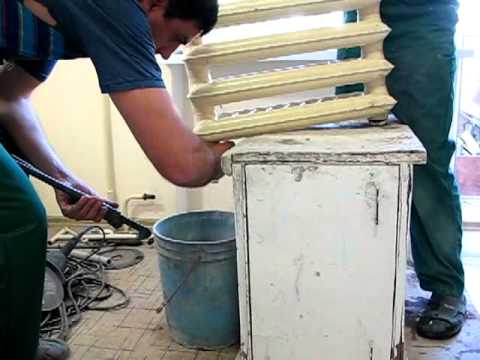
A good result is achieved if you wash the radiators using special additives that help dissolve the contamination, adhered to the inner walls of the batteries.
Than to wash out the battery
This topic is rather discussed, there are quite a few recommendations as to what to wash the cast-iron heating batteries in the home. The rust can be cleaned using:
- soda ash;
- means for washing the radiator of cars;
- whey;
- acetic essences;
- citric acid;
- pepsi-Cola or Coca-Cola.
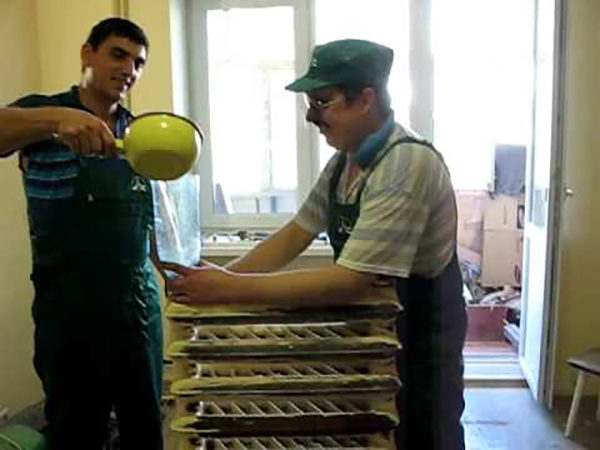
How to rinse iron heating batteries with soda ash? It is recommended to fill the device with hot water with a dissolved agent, install the plugs, leave for an hour or two, periodically shaking the radiator. Then it is necessary to tap all sections of the battery with a wooden hammer to disconnect the rust adhered to the walls.
When using citric acid, you can do without disassembling the battery on the section. To do this, you must put the battery in such a way that the stubs remain below. Citric acid is added in the ratio of one dessert spoon to a liter of water, heated to 95 ° C and poured into the battery. After a while, the radiator is rinsed with hot water under pressure.
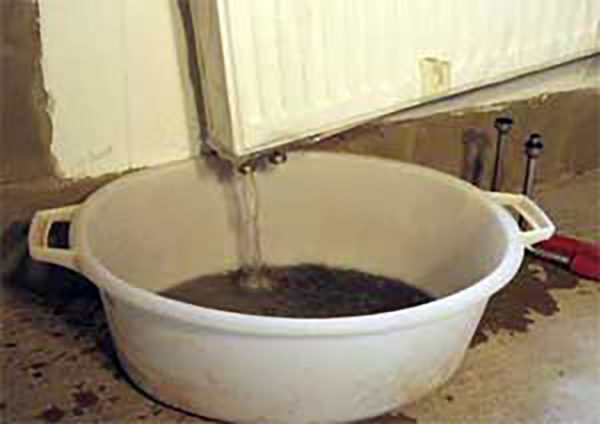
The transparency of the leaky water indicates the cleanliness of the batteries and the readiness for further operation. The work is done, now you can install the radiators in place and monitor the quality of the installation.
Advice! Before mounting the battery, it is recommended to build one cunning device for the future. Its essence is to prevent rust from entering the radiator. Water contains dissolved oxygen, which oxidizes the pipes and leads to corrosion. To prevent rust from entering the radiator, it is possible to install a drain with a plug and a magnet in front of the battery. Now the rust particles will be attracted to the magnet and remain in the tap, which can be periodically cleaned by removing the cap.
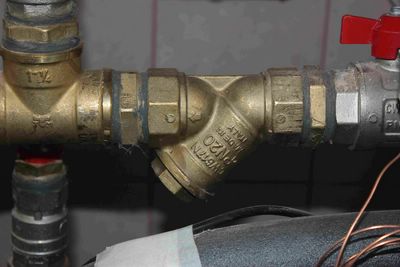
Battery cleaning with special equipment
The cleaning of cast-iron batteries without removal from the place can be carried out with the help of special equipment. The next complex technique is designed for domestic needs:
- pneumatic gun "Typhoon";
- device for electrohydropulse action ZEVS-24;
- device for cleaning the Mole-Mini.
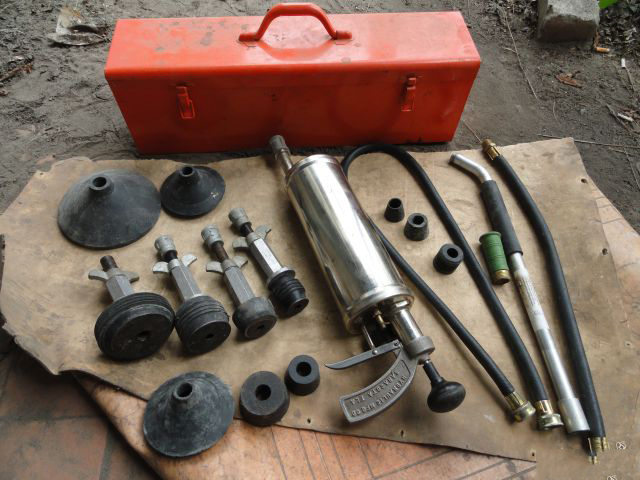
Pneumatic gun "Typhoon"
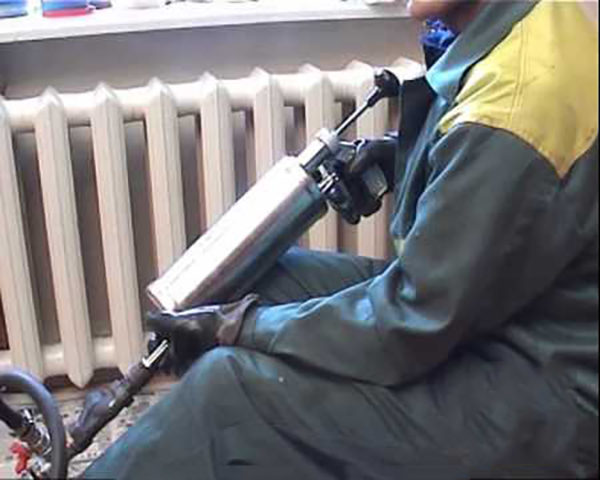
The equipment is compact and simple to handle. It is used to perform a point action on clogging in water and sewer pipes diameter up to 150 mm. The essence of the process is a hydraulic ram to remove hardened deposits from the equipment walls and adjacent risers with a shock wave at a speed of 1.5 km / h, which extends over a distance of up to 60 meters.
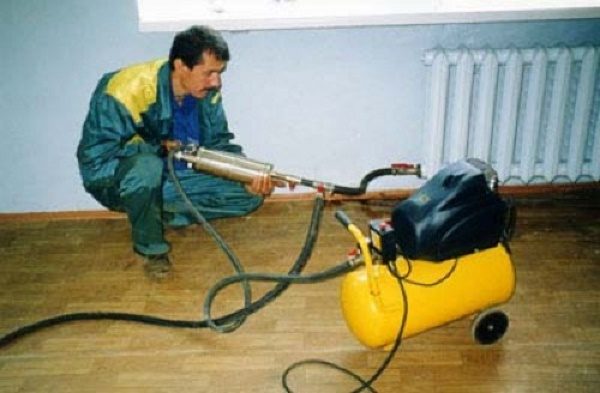
Such cleaning of the heating system makes it possible to clean out clean contaminants that do not respond to conventional hydraulic flushing.
"Typhoon" is indispensable as a plumbing tool for cleaning of clogs in various hard-to-reach placesoh. Depending on the configuration and weight, the device has 6 modifications and the following indicators:
- internal cleaning diameter up to 150 mm;
- the maximum range of fire to the target is 60 m;
- a special valve design for carrying out the kinetic ram;
- a manometer on the body;
- the possibility of manual inflation.

Typically, the "Typhoon" is used in conjunction with the automatic installation of ZEUS-24 and the device for cleaning the hard-to-reach objects of the Mole-Mini.
Installation of ZEUS-24
ZEVS-24 has small dimensions and sufficient power to destroy hardened, tightly adhering to internal walls of heating devices, internal and external water supply and sewerage networks. The essence of his work is based on electrohydropulse effect on solid contamination in pipes with a diameter of 7 to 150 mm. The electric discharge created by the apparatus leads to the appearance of a shock wave and powerful hydrodynamic flows acting on solidified blockages, scale and deposits.
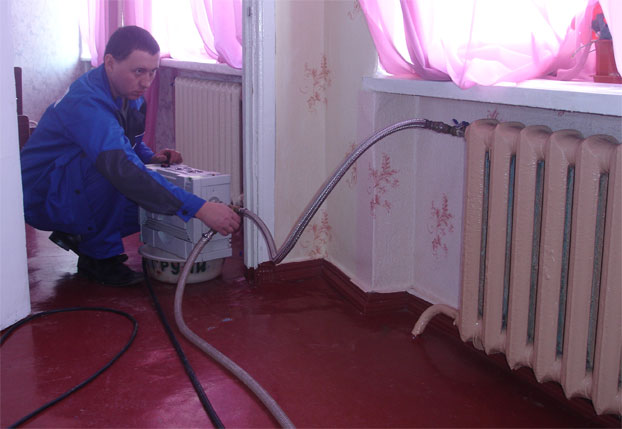
The advantages of the device:
- destruction of blockages of any strength;
- safety of the equipment being cleaned;
- cleaning of hard-to-reach bent and spiral pipes;
- wear resistance of materials of manufacture;
- protective switch-off on the plug.
Installation is used for cleaning pipes with a diameter of 20 to 150 mm. It is compact, has sufficient power, is affordable and indispensable for cleaning in-house sewage networks and other pipelines. The design is convenient in operation, the spiral in the drum makes it possible to clean any hard-to-reach places. The device is intended for a wide range of consumers: from homeowners to housing and communal services, hotels, petrol stations, industrial enterprises.
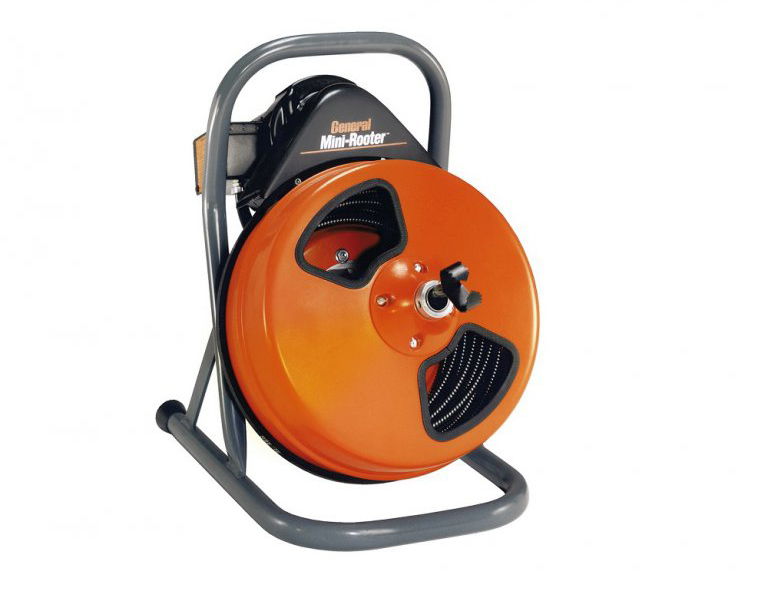
The device has the following advantages:
- the ability to work with different drums and spirals with a diameter of 6 to 13 mm;
- easy procedure for replacing the drum;
- to facilitate the work, the distributing pipe is located inside the drum;
- automatic spiral feed;
- sturdy and flexible spiral made of hardened steel rope, wrapped in hardened steel wire;
- high torque allows you to remove persistent dirt;
- the standard equipment consists of 4 different attachments, allowing complete cleaning of pipes and removal of foreign objects;
- for use in wet rooms, the device is equipped with an RCD.
